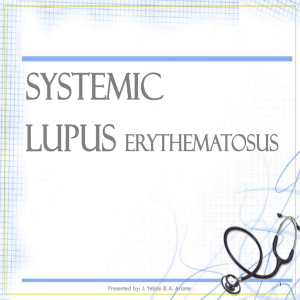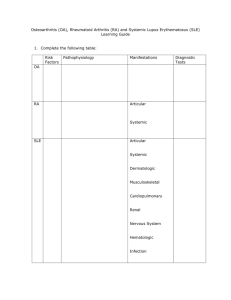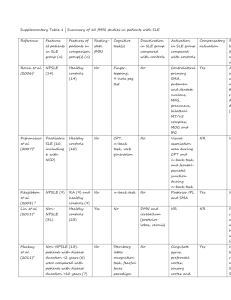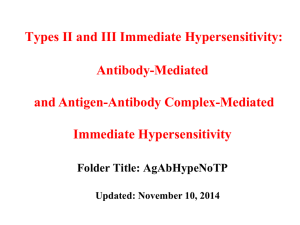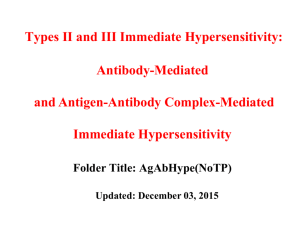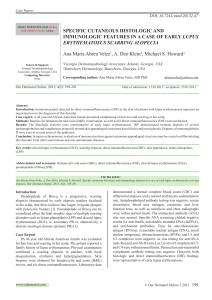systemic_lupus_erythematosus
advertisement
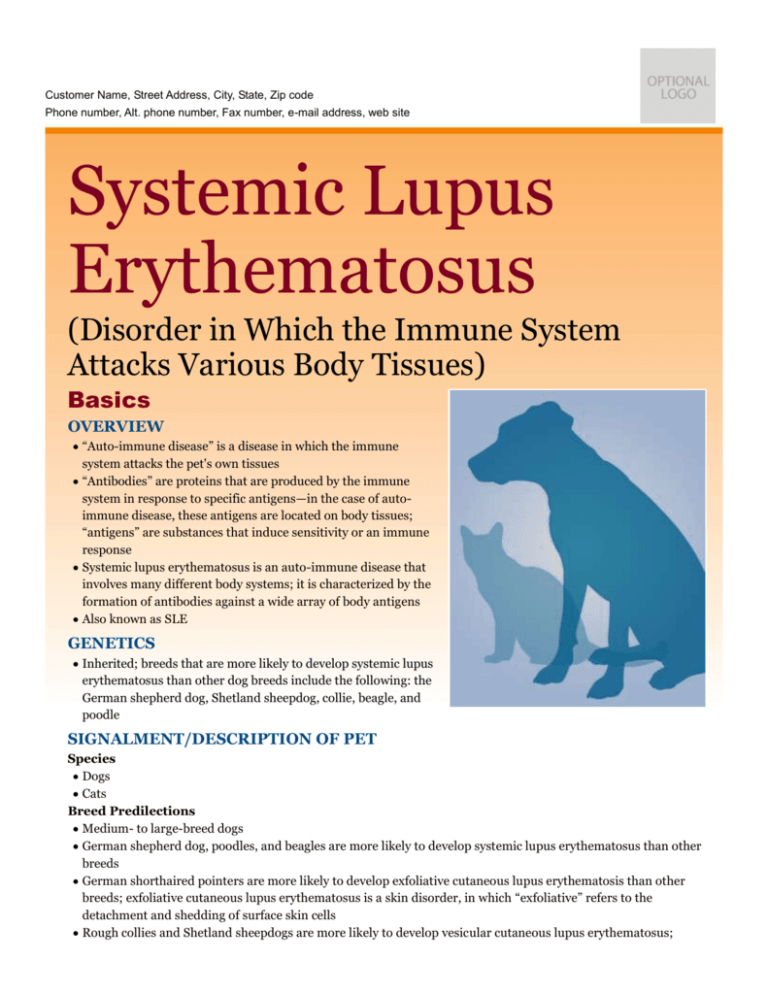
Customer Name, Street Address, City, State, Zip code Phone number, Alt. phone number, Fax number, e-mail address, web site Systemic Lupus Erythematosus (Disorder in Which the Immune System Attacks Various Body Tissues) Basics OVERVIEW • “Auto-immune disease” is a disease in which the immune system attacks the pet's own tissues • “Antibodies” are proteins that are produced by the immune system in response to specific antigens—in the case of autoimmune disease, these antigens are located on body tissues; “antigens” are substances that induce sensitivity or an immune response • Systemic lupus erythematosus is an auto-immune disease that involves many different body systems; it is characterized by the formation of antibodies against a wide array of body antigens • Also known as SLE GENETICS • Inherited; breeds that are more likely to develop systemic lupus erythematosus than other dog breeds include the following: the German shepherd dog, Shetland sheepdog, collie, beagle, and poodle SIGNALMENT/DESCRIPTION OF PET Species • Dogs • Cats Breed Predilections • Medium- to large-breed dogs • German shepherd dog, poodles, and beagles are more likely to develop systemic lupus erythematosus than other breeds • German shorthaired pointers are more likely to develop exfoliative cutaneous lupus erythematosis than other breeds; exfoliative cutaneous lupus erythematosus is a skin disorder, in which “exfoliative” refers to the detachment and shedding of surface skin cells • Rough collies and Shetland sheepdogs are more likely to develop vesicular cutaneous lupus erythematosus; vesicular cutaneous lupus erythematosus is a skin disorder, in which “vesicular” refers to the presence of blisters on the skin • Cat breeds that may be more likely to develop SLE than other breeds—Persian and Siamese Mean Age and Range • Mean age is 5 years; range, 6 months–13 years of age Predominant Sex • Male dogs were more likely to develop systemic lupus erythematosus than female dogs in a single study SIGNS/OBSERVED CHANGES IN THE PET • Onset of signs can be sudden (acute) or subtle (insidious) • Depend on the location in the body (such as skin or joints) where the immune system is attacking the body • Signs vary in intensity—they may increase and decrease over time (known as a “waxing and waning” course) with clinical signs often occurring sequentially • Sluggishness (lethargy) • Lack of appetite (known as “anorexia”) • Shifting-leg lameness; “shifting-leg” lameness is characterized by lameness in one leg, then that leg appears to be normal and another leg is involved • Swollen and/or painful joints—major presenting sign in most affected pets • Symmetrical or localized skin lesions—redness of the skin (known as “erythema”); scaling; superficial loss of tissue on the surface of the skin, frequently with inflammation (known as “ulceration”); loss of pigment in the skin and/or hair coat (known as “depigmentation”); and/or loss of hair (known as “alopecia”) • Fever—especially in the sudden (acute) phase of the disease • Superficial loss of tissue on the surface (ulceration) of the areas of the body where the skin and moist tissues of the body meet (areas known as “mucocutaneous junctions”) and on the moist tissues of the mouth (known as “oral mucosa”) Enlargement of lymph nodes (known as “lymphadenopathy”) • Enlargement of the liver and spleen (known as “hepatosplenomegaly”) • Muscle pain or wasting • Nervous system signs CAUSES • Definitive causes unidentified • A type of lymphocyte, known as a “T-suppressor cell,” may be defective; lymphocytes are a type of white blood cell formed in lymphatic tissues throughout the body RISK FACTORS • Exposure to ultraviolet light may increase the severity of skin lesions Treatment HEALTH CARE • Hospitalization—may be necessary for initial management (such as in a pet with rapid breakdown of red blood cells [known as a “hemolytic crisis”]) • Outpatient management—often possible • Supportive care varies with body systems affected ACTIVITY • Enforced rest—during episodes of sudden (acute) inflammation of several joints (known as “polyarthritis”) • Avoid sunlight if sensitization to light (known as “photosensitization”) is suspected DIET • Low-protein, high-quality protein diet with omega-3 (n-3) fatty acid supplementation—recommended in pets with glomerulonephritis; “glomerulonephritis” is inflammation and accompanying dysfunction of glomeruli (plural of glomerulus) of the kidney; each kidney is composed of thousands of nephrons (the functional units of the kidney, each consisting of the glomerulus [a tuft of blood capillaries—the “blood filter”] and a series of tubes and ducts, through which the filtered fluid flows, as urine is produced); inflammation most commonly is due to the presence of immune complexes in the glomerulus Medications Medications presented in this section are intended to provide general information about possible treatment. The treatment for a particular condition may evolve as medical advances are made; therefore, the medications should not be considered as all inclusive • Steroids—to control the abnormal immune response and reduce inflammation; example is prednisone • Chemotherapy drugs to decrease the immune response—may be added to the treatment when prednisone fails to improve the condition after 7–10 days or if the pet is (or is expected to be) steroid intolerant; possible drugs include azathioprine, cyclophosphamide, or chlorambucil • Cyclosporine—may be tried in pets that do not respond to other medications; use with caution, and withdraw if side effects occur; requires measurement of blood cyclosporine concentration at regular intervals • Levamisole—also may be useful in achieving remission and can be combined with lower dose of prednisone Follow-Up Care PATIENT MONITORING • Physical examination—weekly • Bloodwork, including a complete blood count (CBC) and serum biochemical analysis—to monitor the side effects of chemotherapeutic drugs on day 7, then CBC and possible liver enzymes every 2–4 weeks • Antinuclear antibody (ANA)—the antinuclear antibody test measures antibodies in the blood to the nuclei of cells—it is used in the diagnosis of systemic lupus erythematosus; often remains elevated during remission, but may fall as the pet improves clinically PREVENTIONS AND AVOIDANCE • Do not breed affected pets POSSIBLE COMPLICATIONS • Kidney failure and nephrotic syndrome (a medical condition in which the pet has protein in its urine, low levels of albumin [a type of protein] and high levels of cholesterol in its blood, and fluid accumulation in the abdomen, chest, and/or under the skin) secondary to glomerulonephritis (inflammation and accompanying dysfunction of glomeruli [plural of glomerulus] of the kidney) • Pneumonia, urinary tract infection, or the presence of pus-forming bacteria and their poisons in the blood or tissues (known as “sepsis”) secondary to decrease of the immune response (known as “immunosuppression”) EXPECTED COURSE AND PROGNOSIS • Prognosis is guarded • The presence of low red blood cell count due to the breakdown of red blood cells (known as “hemolytic anemia”) and glomerulonephritis (inflammation and accompanying dysfunction of glomeruli [plural of glomerulus] of the kidney) and the development of bacterial infection warrant a poor prognosis Key Points • Systemic lupus erythematosus is a progressive and unpredictable disease • The pet needs long-term treatment to decrease the immune response (known as “immunosuppressive therapy”) • Immunosuppressive therapy has potentially serious side effects; discuss the side effects with your pet's veterinarian • SLE has been shown to have a genetic basis in some dog breeds Enter notes here Blackwell's Five-Minute Veterinary Consult: Canine and Feline, Fifth Edition, Larry P. Tilley and Francis W.K. Smith, Jr. © 2011 John Wiley & Sons, Inc.

